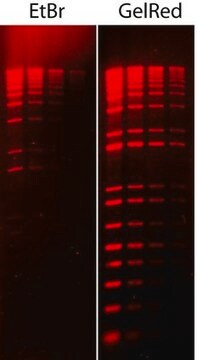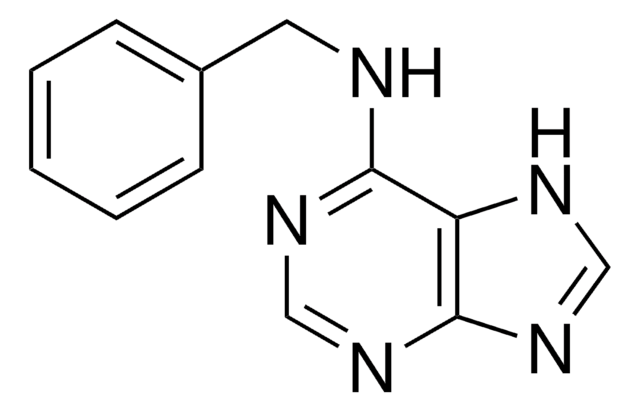所有图片(1)
About This Item
经验公式(希尔记法):
C204H322N56O64 · xC2HF3O2
分子量:
4583.08 (free base basis)
MDL號碼:
分類程式碼代碼:
12352202
NACRES:
NA.32
推荐产品
品質等級
化驗
≥84% (HPLC)
形狀
lyophilized solid
顏色
white
溶解度
H2O: 1 mg/mL
UniProt登錄號
儲存溫度
−20°C
基因資訊
human ... RTN4(57142)
Amino Acid Sequence
Arg-Ile-Tyr-Lys-Gly-Val-Ile-Gln-Ala-Ile-Gln-Lys-Ser-Asp-Glu-Gly-His-Pro-Phe-Arg-Ala-Tyr-Leu-Glu-Ser-Glu-Val-Ala-Ile-Ser-Glu-Glu-Leu-Val-Gln-Lys-Tyr-Ser-Asn-Ser-NH2
應用
Nogo-66(1-40) antagonist peptide has been used as a Nogo-66 receptor antagonist peptide:
- to study the preliminary therapeutic effect after inhibition of Nogo-A in the cauda equina compression (CEC) model
- to determine the effects of Nogo-A/NgR1 on autophagic activation
- to study its role in Nogo-B mediated axonal branching using Schwann cells and sensory neurons of mice
生化/生理作用
Myelin-derived axon outgrowth inhibitors, such as Nogo, may account for the lack of axonal regeneration in the central nervous system (CNS) after trauma in adult mammals. Nogo-66 can inhibit axonal outgrowth through an axonal Nogo-66 receptor (NgR). Competitive antagonists of NgR derived from amino-terminal peptide fragments of Nogo-66. The Nogo-66(1 40) antagonist peptide (NEP1 40) blocks Nogo-66 or CNS myelin inhibition of axonal outgrowth in vitro, demonstrating that NgR mediates a significant portion of axonal outgrowth inhibition by myelin. Intrathecal administration of NEP1 40 to rats with mid-thoracic spinal cord hemisection results in significant axon growth of the corticospinal tract, and improves functional recovery. Thus, Nogo-66 and NgR have central roles in limiting axonal regeneration after CNS injury, and NEP1-40 provides a potential therapeutic agent.
法律資訊
Sold under a non-exclusive license. For research use only, and not for diagnostic or therapeutic use or for use in humans.
儲存類別代碼
11 - Combustible Solids
水污染物質分類(WGK)
WGK 3
閃點(°F)
Not applicable
閃點(°C)
Not applicable
個人防護裝備
Eyeshields, Gloves, type N95 (US)
Wei Xu et al.
Neuroscience, 431, 103-114 (2020-02-19)
Focal cerebral infarction leads to autophagic activation, which contributes to secondary neuronal damage in the ipsilateral thalamus. Although Nogo-A deactivation enhances neuronal plasticity, its role in autophagic activation in the thalamus after ischemic stroke remains unclear. This study aimed to
Tadzia GrandPré et al.
Nature, 417(6888), 547-551 (2002-05-31)
Myelin-derived axon outgrowth inhibitors, such as Nogo, may account for the lack of axonal regeneration in the central nervous system (CNS) after trauma in adult mammals. A 66-residue domain of Nogo (Nogo-66) is expressed on the surface of oligodendrocytes and
Neutralization of Nogo-A enhances synaptic plasticity in the rodent motor cortex and improves motor learning in vivo.
Zemmar A, Weinmann O, Kellner Y, et al.
The Journal of Neuroscience, 34(26), 8685-8698 (2014)
Xiaofei Sun et al.
Biochemical and biophysical research communications, 527(1), 131-137 (2020-05-25)
To investigate the expression of Nogo-A in dorsal root ganglion (DRG) in rats with cauda equina injury and the therapeutic effects of blocking Nogo-A and its receptor. Fifty-eight male Sprague-Dawley rats were divided randomly into either the sham operation group
Peng Zhai et al.
Biomedical materials (Bristol, England), 10(4), 045016-045016 (2015-08-05)
The adult mammalian central nervous system has limited ability to regenerate after injury. This is due, in part, to the presence of myelin-associated axon growth inhibitory proteins such as Nogo-A that bind and activate the Nogo receptor, leading to profound
我们的科学家团队拥有各种研究领域经验,包括生命科学、材料科学、化学合成、色谱、分析及许多其他领域.
联系技术服务部门








